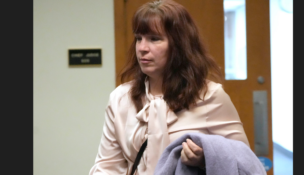Facing mostly white juries, are Milwaukee County defendants of color truly judged by their peers?
By: Bridgetower Media Newswires//April 24, 2024//
Facing mostly white juries, are Milwaukee County defendants of color truly judged by their peers?
By: Bridgetower Media Newswires//April 24, 2024//
By Chris Ramirez, Milwaukee Journal Sentinel
It took prosecutors years to get Eric Bills into a courtroom to answer charges in the death of Jemell McMillan.
Bills was nowhere to be found after McMillan’s Sept. 29, 2016, execution-style shooting, but was arrested about three years after the killing.
The case was then beset by delays — some legal in nature, others tied to the COVID-19 pandemic.
So, when his trial finally got underway late last year, all the pieces seemed to be in place for Bills to have his day in court.
That is, until jury selection started.
Forty potential jurors were brought in to judge whether he was guilty. Just three were Black.
Attorneys for Bills, a 38-year-old Black man from Milwaukee’s northwest side, made note of it and asked for a new panel.
“There have been times where I and my client are the only people of color in the courtroom,” said Milwaukee attorney Meera Al-Henaey, who represented Bills at trial. “It makes you wonder how this can even happen in a place like Milwaukee.”
Lawyers, defendants, even some judges acknowledge there are times — many times — that juries in Milwaukee County appear to lack diversity.
The Constitution, after all, assures anyone accused of a crime the right to be judged by a jury of their peers.
So for defendants of color, is Milwaukee County providing adequate justice?
How are Wisconsin jurors selected?
For years in Wisconsin, selecting a jury has meant assembling a panel derived from state drivers’ license data sets.
Roughly 200,000 summonses for jury service are issued each year, according to the Wisconsin Court System. These summonses result in about 65,000 individuals reporting to courthouses for jury duty.
The summonses are drawn from the estimated 4.3 million people who, according to state transportation records, were registered to drive motor vehicles in Wisconsin.
The reliance on drivers’ licenses has been a major factor in the lack of diversity in Milwaukee County juries.
Just 22 percent of 18-year-old Black men in the county have a driver’s license, compared with 31 percent of white men the same age, according to a 2015 report by the University of Wisconsin-Milwaukee Employment & Training Institute.
The same institute found that 47 percent of Black adults in Wisconsin in 2005, its most recent citation, held valid drivers’ licenses, compared with 73 percent of white adults that year.
Add in that Milwaukee County has by far the busiest courthouse, with roughly 150,000 case files each year, many of which require a jury.
The result? Black defendants in the county are proportionally less likely to face Black jurors at trial.
Why is jury diversity important in Wisconsin, and especially Milwaukee County?
That discrepancy becomes more important because of the people charged with crimes in Wisconsin.
Milwaukee County’s population was 918,661 as of July 1, 2022, according to the latest data provided by the U.S. Census Bureau. Of that, 27.1% — or roughly 289,000 people — identified as Black/African American. Another 150,000 people — 16.6% — identified that year as Hispanic or Latino.
Yet, people of color statistically represent a disproportionately higher volume of the defendants who appear before a judge and jury in Wisconsin and, in many instances, are convicted of crimes.
An October 2021 report by The Sentencing Project found that, despite accounting for just 6% of Wisconsin’s population, Blacks made up 42% of the state’s prison population. It also determined Blacks are incarcerated at 12 times the rate of white people.
Hispanic individuals were incarcerated at more than twice the rate of white people in Wisconsin, surpassing the national average of 1.3 Hispanic people for every white person, the report found.
Another report, in October, by the Center for Popular Democracy and the Milwaukee-based Black Leaders Organizing for Communities, or BLOC, examined how policing and incarceration affected their community’s ability to participate in democracy.
The report focused on residents living on Milwaukee’s north side, where a large share of the state’s entire Black population lives. It found many of its residents are among the most incarcerated in the country, a trend the group argues can be traced to an “entrenched historic and ongoing racial segregation, economic exclusion.”
What does the lack of jury diversity mean for Milwaukee County defendants of color?
The lack of Blacks and other people of color participating in local juries is yet another stage of evolution in segregation, BLOC argues.
“When you have a Black defendant and an all-white jury … they don’t have any lived experience of that individual. They can’t relate,” said Keisha Robinson, BLOC’s deputy director. “Not having a jury of your peers tips the scale against you.”
BLOC recently hosted a panel discussion that focused on challenges and barriers to jury duty for people of color in Milwaukee. The event was highlighted by a screening of “Judging Juries,” a documentary that chronicled efforts being made to increase minority participation in juries in California’s Bay Area.
There, jury service was seen as a financial hardship. Among the strategies offered in the film was to increase daily jury duty pay from $15 to $100.
“All juries should be diverse, whether it’s a Black defendant or whatever,” Robinson said. “There should be diverse opinions when you’re deciding someone’s life.”
Milwaukee County judges recognize the lack of jury diversity, too
Judges aren’t blind to the phenomenon.
Milwaukee County circuit court judges Jonathan D. Richards and Danielle L. Shelton say they’ve sent juries back to the drawing board when lawyers pick a panel they felt wasn’t diverse enough.
And there are times when some people of color show up for jury duty, but are eliminated by lawyers in the case during jury selection. While lawyers are allowed to strike a potential juror if they express a bias, they also can use a limited number of peremptory challenges to reject a juror without giving a reason.
Shelton, who was elected to the bench in 2019, recalled a time when a prosecutor eliminated each Black panelist in a case in which the defendant also was Black.
She questioned the prosecutor’s decision to cut one particular juror.
“He was a teacher who’s married; he had kids. … I didn’t see anything wrong with him,” Shelton said. “I said, ‘Why did you strike this person?’ And she said, ‘Well, I was worried that he wasn’t paying attention because he was looking at his feet.'”
Richards said he has tracked the diversity of jurors in his courtroom over time. He has called for new juries after noting a racial imbalance on the panel, even though doing so can make a trial stretch a bit longer.
In one recent homicide trial, he was given a jury pool of 35 people. Just two of the panelists were Black. So he requested a new pool. That time, six of the 35 jurors were Black.
“Not having representative jury panels is a constant problem we have in Milwaukee County,” Richards said.
Solutions to the lack of jury diversity could include using state ID cards, hunting and fishing licenses
Court officials at the state and local level worried about bad optics in cases involving defendants of color are looking for solutions.
The Wisconsin Criminal Justice Coordinating Council’s Subcommittee on Race Equity, Inclusion and Access has been working on strategies to attract more minorities to serve on juries. It’s part of its goal to eliminate what it deemed systematic barriers to racial and ethnic fairness in the criminal justice system.
For the first time, residents who hold state ID cards are now part of a statewide master list of potential jurors after the subcommittee recently inquired about including them.
It’s still early in the process, but the subcommittee says the volume of Black and Hispanic jurors in Dane and Milwaukee counties has climbed within weeks of adding ID holders to the pool.
The group also is recommending that other state licensures — including hunting and fishing licenses — be included for jury-duty eligibility.
“Juries are the voice of the community and hold the justice system accountable to the rule of law. Yet there continue to be barriers to jury service,” said state Supreme Court Justice Rebecca Frank Dallet, who founded the subcommittee. “(We’re) committed to breaking down those barriers.”
Dallet said the committee also has been exploring the use of the other lists to find potential jurors. Among them is the Department of Revenue list of state income tax returns.
It’s considered the most comprehensive source list in Wisconsin. However, getting access to it isn’t so simple.
State law restricts which agencies can get the information. The Director of State Courts isn’t allowed. The state Assembly would need to add an exception to the statute for that to happen.
Regardless, efforts to make juries more reflective of the communities they serve are both necessary and can’t happen fast enough, said William F. Sulton, president of the ACLU’s Wisconsin chapter.
“All-white juries can be fair, but we’re talking about the optics,” said Sulton, a defense attorney whose law firm is headquartered in Milwaukee’s largely Black Harambee neighborhood.
Lack of jury diversity leads to ‘systematic exclusion and significant underrepresentation’
It’s a problem that Al-Henaey believed was worth highlighting to ensure her client, Bills, would be tried before a jury that was truly made up of his peers.
Bills went on trial in October for killing McMillan, 36, during an argument in September 2016.
The shooting was carried out in front of a group of people on North 37th Street. Among them was Britany N. Jackson. Prosecutors said she gave information to police about the shooting and later turned up dead.
Another man, Deruntae Mason, was convicted of killing Jackson. He later testified he did so under duress from Bills.
Al-Henaey and attorney Arial Rosenberg filed a motion requesting a new jury in Bills’ trial, challenging, in part, how Milwaukee County picks its jurors.
They argued using a drivers’ license list as the sole source for a jury pool leads to the “systematic exclusion and significant underrepresentation of Black residents.”
“Milwaukee County uses a source for eligible jurors that is well-known as underrepresenting our county’s black residents,” they wrote. “This is especially egregious when there are, by statute, other sources it may use to supplement its main source.”
A judge denied Al-Henaey and Rosenberg’s request for a new jury. Bills was convicted after deliberating 2½ hours.
Al-Henaey wouldn’t comment on the specifics of Bills’ case when reached by the Journal Sentinel, but said she remained concerned that drawing from only licensed drivers would eliminate potential jurors, particularly those who are Black and Hispanic.
“Regardless of whether a person is guilty or not guilty, we want the process to be done fairly,” Al-Henaey said. “The Constitution is supposed to ensure you a fair cross-section of the community, not a cross-section of licensed drivers.”
This article was originally published in the Milwaukee Journal Sentinel and was republished with permission.
Legal News
- Wisconsin lawyers file University of Wisconsin public records request seeking answers to protests
- Wisconsin Supreme Court issues orders amending Supreme Court rules and Wis. Stats.
- EXCLUSIVE: Former Milwaukee ‘big law’ partner attacks news media for bias against Trump
- Former Milwaukee election official fined for obtaining fake absentee ballots
- Contract dispute prevents airing of 15 regional sports networks, impacts Brewers
- Wis. middle school focuses on recovery as authorities investigate shooting
- Gov. Evers seeks applicants for Sheboygan and Green County Sheriffs
- North Carolina man who harbored Nazi memorabilia and attacked Black and Latino men sentenced to 41 months
- Nation grieves with families of officers killed in NC
- Amended complaint filed in federal court against State Bar of Wisconsin seeks punitive damages
- United Healthcare suit against cancer drug distributor time-barred
- Trump’s Wisconsin visit warns of jail time if he violates a trial gag order
WLJ People
- Power 30 Personal Injury Attorneys – Russell Nicolet
- Power 30 Personal Injury Attorneys – Benjamin Nicolet
- Power 30 Personal Injury Attorneys – Dustin T. Woehl
- Power 30 Personal Injury Attorneys – Katherine Metzger
- Power 30 Personal Injury Attorneys – Joseph Ryan
- Power 30 Personal Injury Attorneys – James M. Ryan
- Power 30 Personal Injury Attorneys – Dana Wachs
- Power 30 Personal Injury Attorneys – Mark L. Thomsen
- Power 30 Personal Injury Attorneys – Matthew Lein
- Power 30 Personal Injury Attorneys – Jeffrey A. Pitman
- Power 30 Personal Injury Attorneys – William Pemberton
- Power 30 Personal Injury Attorneys – Howard S. Sicula












